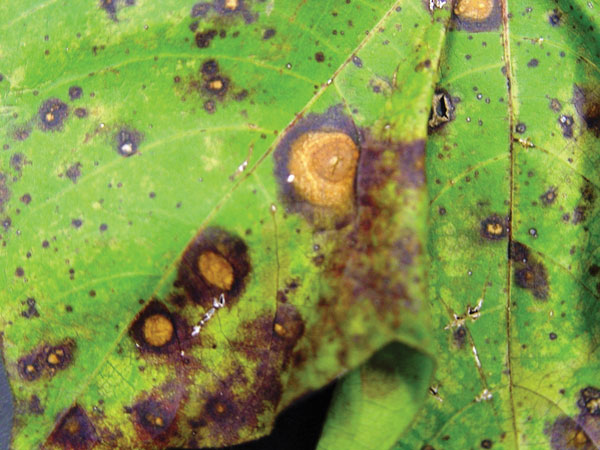November 8, 2013

Reviewing the science to date on Corynespora cassiicola — incited leaf spot, Cotton Incorporated Senior Director Bob Nichols says the only clear answer at this point is that it’s a problem.
Nichols is working with researchers across the Southeast to undertake research on this emerging disease commonly known as target spot.
The disease was first found in southwest Georgia around 2005 and positively identified in 2009 by Bob Kemerait, University of Georgia pathologist. “Why does Nichols show up at a place?” Kemerait asks rhetorically. “Because there’s a problem. We have a problem.”
The question is how to manage it. Everything we think so far is being questioned, Nichols says, including foundational issues — such as, does the disease begin in periods of heavy rainfall or is heavy dew enough?
Answers to some questions haven’t been studied yet — such as whether nutrition plays a role in opening the door to this opportunistic disease, because target spot is apparently a disease of lush cotton and not of potash-deficient cotton.
Austin Hagan, Auburn University pathologist, saw more target spot in 2012 than in 2013, despite recording 30 more inches of rain this year at one of his research locations.
“The rainfall happened earlier this year suggesting there is an interaction with crop age, fertility demands, and the ability of target spot to establish itself” says PhytoGen cotton development specialist, Russell Nuti.
The priority questions for cotton growers are:
• Should susceptibility to target spot be considered when choosing varieties?
• Does target spot impact yield?
• Is a fungicide application economically advantageous?
Target Spot Risk Index
A recently created Target Spot Risk Index, available from the University of Georgia at http://nwdistrict.ifas.ufl.edu/phag/files/2013/07/2013-Cotton-target-spot-index.pdf, notes: “The exact relationship between defoliation and yield loss is not completely understood. For example a variety with more defoliation than another variety may not necessarily yield less.”
For example, in more than one trial, PhytoGen brand PHY 499 WRF was among those with a higher target spot rating; it also produced the highest yield in those trials. Nuti notes “target spot ratings are based heavily on defoliation and it is difficult to separate defoliation caused by plant maturity from defoliation caused purely by disease.”
To further complicate the issue, Georgia produced a record-breaking average yield — 1,091 pounds per acre — in 2012, when target spot pressure was considered the most intense year ever. That yield was more than 200 pounds higher than in 2009, the first year target spot was positively identified in a small geography in southwestern Georgia.
In an anecdotal case, a Dooly County, Ga., farmer with a majority of his acreage planted to PHY 499 WRF in 2012 reported significant target spot and averaged 1,530 pounds per acre on the acreage he planted to PHY 499 WRF.
This agronomic oxymoron is compounded by fungicide trials in which applications sometimes show a yield benefit but frequently do not.
Nichols suspects misplaced application is the root cause of the inconsistent fungicide result. Timing and coverage are the primary issues he wants to see researched.
“The problem is we’re not getting the fungicide to where the disease is,” Nichols says. “I think the fungicide treatments would work better if we put them where the fungus is sporulating.”
Nichols suggests researchers look at timing based on vegetative growth rather than on bloom. “This is a new disease. Maybe we need to talk about it in new ways,” he says.
Kemerait believes the target spot risk assessment index is the path down which Extension should send growers and consultants. “If every grower in the state looks at this disease and says, ‘I need to apply fungicide,’ then they’re sadly wrong,” Kemerait says.
“If a grower looks at it carefully and weighs his risk then chooses to apply fungicide, that’s the way to go.”
Target spot was found in southwest Georgia around 2005, tentatively identified by University of Georgia researchers in 2008 and positively confirmed in 2009.
Cases were reported in Alabama in 2011; Mississippi, South Carolina and North Carolina in 2012; and in Louisiana this year.
Steve Brown, PhytoGen cotton development specialist, expected more conclusive research results by harvest 2013. That hasn’t happened.
“Research so far shows this disease doesn’t adversely impact lint quality and average yields broke records in the year when we saw the most target spot pressure,” Brown says.
“Answers still are needed on so many issues, even fundamental questions such as: When does target spot reduce yield? When does a fungicide application pay for itself?”
More from Southeast Farm Press
Southeast winter weather to vary widely
Growers should like two new high oleic peanut varieties
U.S. farm export interests pushing for changes in China's biotech policies
High winds knock down Kentucky corn: Here are some harvest tips
You May Also Like




